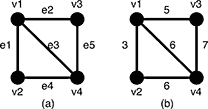POJ - 3522 Slim Span (kruskal+枚举)
来源:互联网 发布:mastercam9.1三维编程 编辑:程序博客网 时间:2024/04/28 07:27
Description
Given an undirected weighted graph G, you should find one of spanning trees specified as follows.
The graph G is an ordered pair (V, E), where V is a set of vertices {v1,v2, …, vn} and E is a set of undirected edges {e1,e2, …, em}. Each edge e ∈ E has its weightw(e).
A spanning tree T is a tree (a connected subgraph without cycles) which connects all the n vertices withn − 1 edges. The slimness of a spanning tree T is defined as the difference between the largest weight and the smallest weight among then − 1 edges of T.

Figure 5: A graph G and the weights of the edges
For example, a graph G in Figure 5(a) has four vertices {v1,v2, v3, v4} and five undirected edges {e1,e2, e3, e4, e5}. The weights of the edges arew(e1) = 3, w(e2) = 5, w(e3) = 6, w(e4) = 6, w(e5) = 7 as shown in Figure 5(b).

Figure 6: Examples of the spanning trees of G
There are several spanning trees for G. Four of them are depicted in Figure 6(a)~(d). The spanning treeTa in Figure 6(a) has three edges whose weights are 3, 6 and 7. The largest weight is 7 and the smallest weight is 3 so that the slimness of the treeTa is 4. The slimnesses of spanning trees Tb,Tc and Td shown in Figure 6(b), (c) and (d) are 3, 2 and 1, respectively. You can easily see the slimness of any other spanning tree is greater than or equal to 1, thus the spanning tree Td in Figure 6(d) is one of the slimmest spanning trees whose slimness is 1.
Your job is to write a program that computes the smallest slimness.
Input
The input consists of multiple datasets, followed by a line containing two zeros separated by a space. Each dataset has the following format.
Every input item in a dataset is a non-negative integer. Items in a line are separated by a space. n is the number of the vertices and m the number of the edges. You can assume 2 ≤n ≤ 100 and 0 ≤ m ≤ n(n − 1)/2. ak andbk (k = 1, …, m) are positive integers less than or equal ton, which represent the two vertices vak andvbk connected by the kth edge ek.wk is a positive integer less than or equal to 10000, which indicates the weight ofek. You can assume that the graph G = (V, E) is simple, that is, there are no self-loops (that connect the same vertex) nor parallel edges (that are two or more edges whose both ends are the same two vertices).
Output
For each dataset, if the graph has spanning trees, the smallest slimness among them should be printed. Otherwise, −1 should be printed. An output should not contain extra characters.
Sample Input
4 51 2 31 3 51 4 62 4 63 4 74 61 2 101 3 1001 4 902 3 202 4 803 4 402 11 2 13 03 11 2 13 31 2 22 3 51 3 65 101 2 1101 3 1201 4 1301 5 1202 3 1102 4 1202 5 1303 4 1203 5 1104 5 1205 101 2 93841 3 8871 4 27781 5 69162 3 77942 4 83362 5 53873 4 4933 5 66504 5 14225 81 2 12 3 1003 4 1004 5 1001 5 502 5 503 5 504 1 1500 0
Sample Output
1200-1-110168650
题意:求最小生成树最大边和最小边的最小差值
思路:kruskal排序后每次第一个选的和最后一个选的就是差值,找到最小的
#include <iostream>#include <cstdio>#include <cstring>#include <algorithm>#include <queue>using namespace std;const int maxn = 110;const int inf = 0x3f3f3f3f;struct Edge {int from, to, dist;} edge[maxn*maxn];int n, m;int ans, fa[maxn];int cmp(Edge a, Edge b) {return a.dist < b.dist;}void init() {for (int i = 1; i <= n; i++)fa[i] = i;}int find(int x) {if (x != fa[x])fa[x] = find(fa[x]);return fa[x];}void kruskal() {ans = inf;sort(edge, edge+m, cmp);for (int i = 0; i < m; i++) {init();int cnt = 0, tmp = inf;for (int j = i; j < m; j++) {int fx = find(edge[j].from);int fy = find(edge[j].to);if (fx != fy) {fa[fx] = fy;cnt++;if (cnt == n-1) {tmp = edge[j].dist - edge[i].dist;break;}}}if (tmp < ans)ans = tmp;}}int main() {while (scanf("%d%d", &n, &m) != EOF && n+m) {for (int i = 0; i < m; i++)scanf("%d%d%d", &edge[i].from, &edge[i].to, &edge[i].dist);kruskal();if (ans == inf) printf("-1\n");else printf("%d\n", ans);}return 0;}- POJ 3522 Slim Span kruskal+枚举。
- POJ 3522 Slim Span (Kruskal+枚举)
- poj 3522 Slim Span (Kruskal+枚举)
- POJ - 3522 Slim Span (kruskal+枚举)
- poj 3522 Slim Span(Kruskal+枚举)
- POJ 3522 slim span Kruskal
- POJ 3522 Slim Span (并查集 + 枚举 + kruskal)
- poj 3522 Slim Span【kruskal算法】
- poj-3522-Slim Span-kruskal活用
- POJ 3522 Slim Span (Kruskal +枚举 边权差最小的生成树)
- poj 3522 Slim Span(最小生成树)kruskal算法
- POJ 3522 Slim Span(最小生成树-Kruskal)
- poj 3522 Slim Span(最小生成树 Kruskal算法)
- POJ 3522-Slim Span(苗条树-kruskal生成树)
- 最小生成树kruskal POJ 3522 Slim Span
- POJ 3522 Slim Span
- poj 3522 Slim Span
- POJ 3522 Slim Span
- 9.asm-汇编mov,lea+[]寻址 小结
- Ajax 两点记录
- Farey Sequence+欧拉函数打表+模板题+poj
- Android模拟神器——Genymotion
- HNU 12834 Thread Tree
- POJ - 3522 Slim Span (kruskal+枚举)
- 原来还有什么身份是士大夫
- UVa10522 - Height to Area(海伦公式)
- 快速开发05之不做重复的事情——样式一样快速复制
- UVa10723 Cyborg Genes
- 发货的规划局投入日uiyui
- 重新整理反射--基础
- 的分公司的发货的体育体育
- Java虚拟机读书笔记


